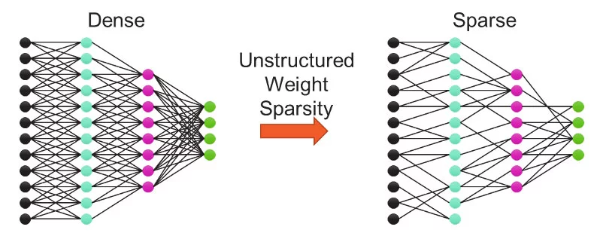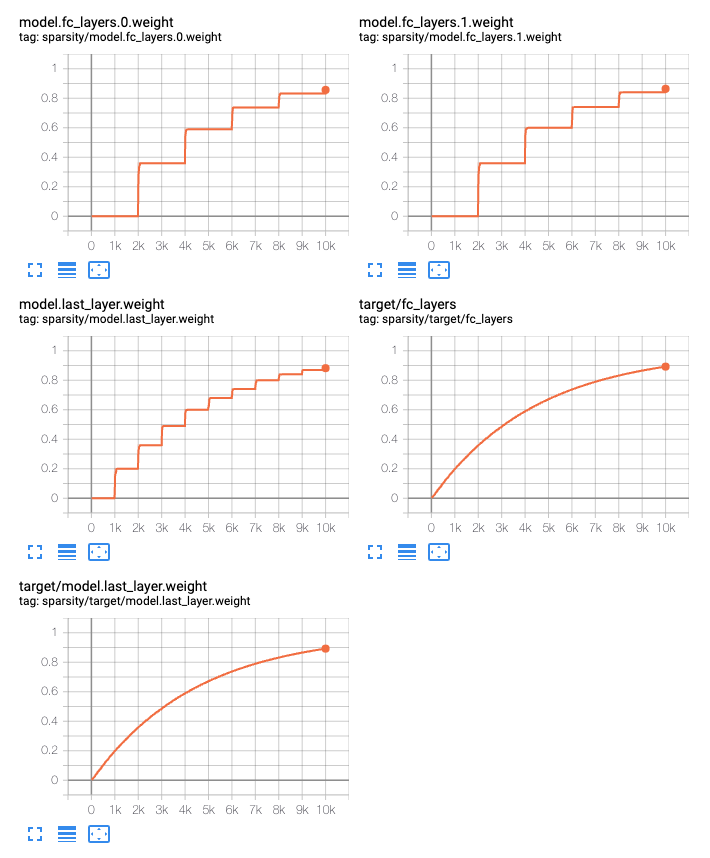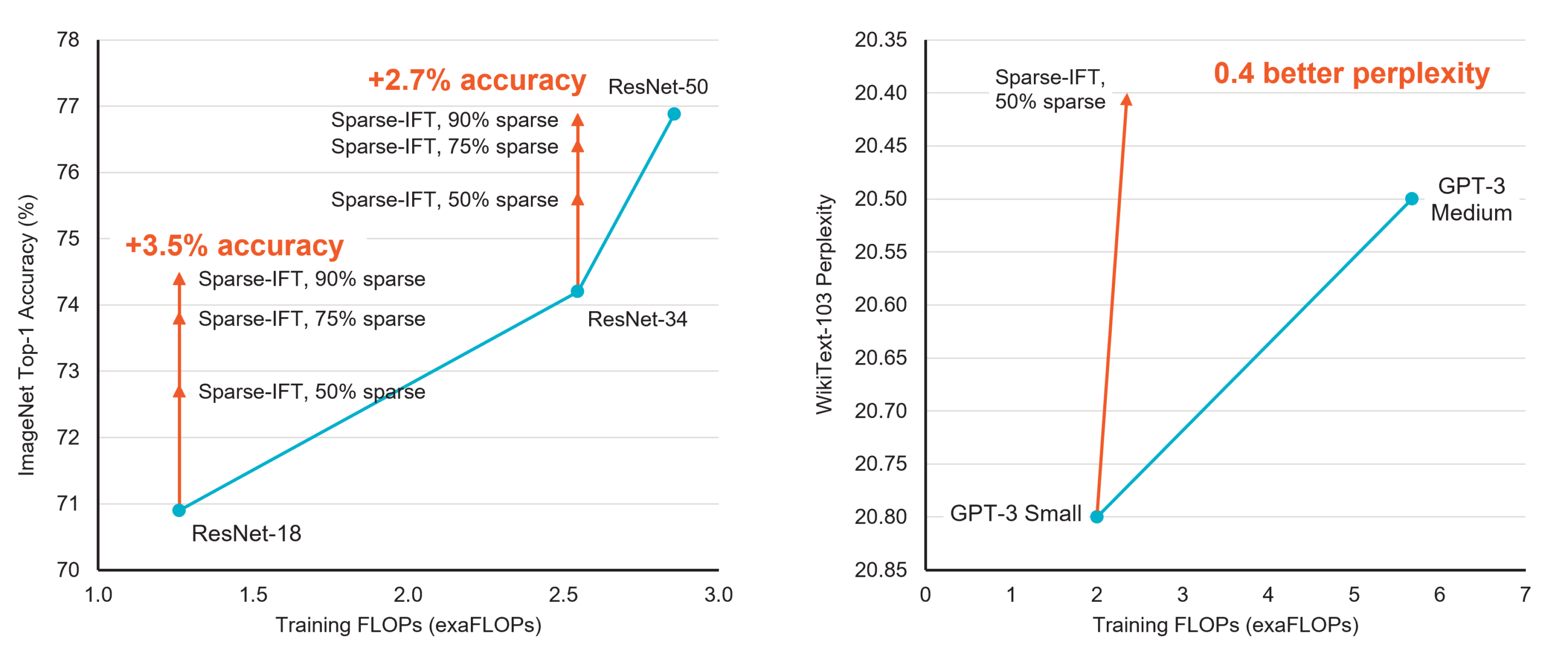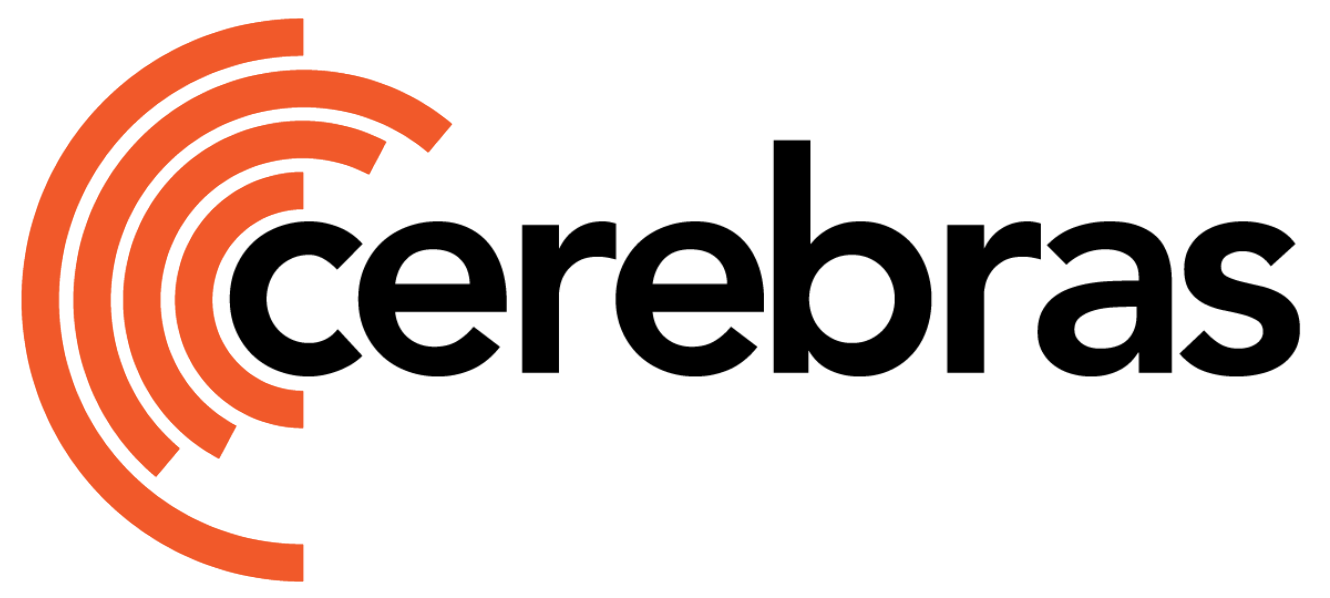Trainer with weight sparsity. By the end, you should be familiar with how to use sparsity in tandem with the Trainer for any model.
Prerequisites
Make sure to have read through Trainer Overview and Trainer Configuration Overview which provide the basic overview of how to run Model Zoo models. In this document, you will be using the tools and configurations outlined in those pages.Background
In 2018, state-of-the-art neural networks such as BERT had a few hundred million parameters. Two years later, the world was introduced to GPT-3. With 175 billion parameters and a 3.14*1023 FLOPs (floating point operations) compute budget, it is estimated to have required 10,000 NVIDIA V100 GPUs for 15 days, accounting for 552 tons of CO2e emissions and 1,287 MWh of energy [Patterson et al.]. Evidently, training large models is costly. With parameter counts and datasets getting larger and larger every year, new approaches are needed to reduce the time, energy, and carbon footprint required to train. Weight sparsity, coupled with hardware that accelerates it, is a promising way to train models using significantly less compute and memory.
Configure Sparsity
Let’s expand on the minimal example shown in sparsity. For example, with the following config, the sparsity level is set to 0.3 (30%), andinit_method is "random", which means 30% of the elements in each Parameter (which passes the default parameter filter) will be pruned once at model initialization and kept that way throughout training. Non-Parameter tensors are not pruned.
-
algorithm:You can also define a custom class that inherits fromSparsityAlgorithm.
- YAML: As long as the class in the global scope, i.e. by importing it in your run.py, it can be directly used in a YAML config, e.g.
- Python: The CustomSparsity class can be passed directly to the Trainer as seen below.
sparsity:The desired sparsity level between 0 and 1. 0.0 means the Parameter is kept fully dense. 1.0 means the Parameter is effectively entirely zeros. Dynamic sparsity algorithms also accept more complex configuration described below in Dynamic Hyperparameters.
The actual sparsity level may not match the target sparsity level in practice. The target sparsity level only represents a target distribution. The true sparsity level is determined by the size of the Parameter that is being sparsified.For example, if you were to sparsify a Parameter with shape (5,) targeting a sparsity level of 0.5, the actual sparsity level will only ever be 0.4. The smaller the Parameter, the more extreme this discrepancy becomes. If the Parameter is a scalar tensor, then the actual sparsity level will always either be 0.0 or 1.0.
-
init_methodoptional:Method to compute the initial sparsity distribution.-
random: (default) Sparsity is randomly distributed within each weight. -
topk: Sparsity is distributed according to the lowest magnitude weights. -
from_zeros: Sparsity pattern is determined by weight values that are already zero.
-
-
param_filteroptional:Controls which Parameters are sparsified. The list of Parameter names can be found usingmodel.named_parameters(). When this is omitted, any multidimensional Parameters (except those withembedding,norm, orlm_headin their name) automatically get sparsity applied (single dimensional weights such as biases are ignored) (Seedefault_sparse_param_filter).While this provides a good default heuristic for transformer based models 1, a (list of) glob expressions can also be provided to only apply sparsity to Parameters which match, e.g.```Bash trainer: init: sparsity: … param_filter:- “*dense_layer.weight”
-
“*linear_layer.weight”
```To match all weights, set
param_filter: *Per-layer sparsity options can be configured by passing in a list of configuration dictionaries. See below in advanced param_filters.
Dynamic Sparsity Update Schedule
Dynamic sparsity (e.g.GMP, SET, or RigL) needs an additional update schedule indicating when to update the sparsity pattern. There are 2 basic methods built-in with 3 different options:
Regular Interval
When sparsity should be updated at a regular interval, a single frequency can be given:Irregular Interval
When sparsity should be updated at arbitrary steps, specify them in a list:Dynamic Hyperparameters
Dynamic sparsity algorithms (e.g.GMP, SET, or RigL) can configure the sparsity (and drop_fraction for SET and RigL) field using a “step aware hyperparemeter” akin to learning rate schedules in addition to simple constants. These more complex configurations usually require additional options and so are specified as dictionaries.
NoteThe base
DynamicSparsityAlgorithm that invokes such a dynamic hyperparameter for sparsity ensures sparsity levels stay legal by using torch.clamp(sparsity, min=0.0, max=1.0).Linear
Exponential
GMP, where the sparsity level monotonically increases throughout training because a fraction of the remaining elements in the Parameter are pruned at each update step, asymptotically approaching an empty network.
Cosine
RigL, which usually uses a “cosine decay” on its drop_fraction. minimum defaults to 0.0. half_period controls what step the value reaches its minimum.
More Config examples
The most basic configuration, applying random 30% sparsity to all Parameters:Configuring Multiple Sparsity Algorithms
Different groups of Parameters can be sparsified using different sparsity algorithms. For example, if one set of weights should be statically sparsified to say0.3, but another set of weights should be dynamically sparsified using the SET algorithm, it can be done by providing a list of sparsity algorithms.
Advanced param_filters
When each Parameter (or group of Parameters) needs different configuration, param_filters can be specified as a dictionary, mapping “patterns” to the config dictionaries to overlay on the default sparsity config options.
For example, when using RigL on transformer networks (uses gradient information to guide which values in a Parameter to prune), sparsity can be cyclically restributed between the heads of attention projection weights in case samples in a batch activate one head disproportionately to another. This ultimately decreases the effectiveness of dynamic sparsity and even can hurt model performance.
To ensure sparsity is fairly distributed between the different attention heads of the multi-head attention projections, you can specify balance_out_groups when the output logits are logically N independent/stacked groups (i.e. input projection weights before multi-head attention QKV), or balance_in_groups for the reverse (i.e. output projection weights). These should apply differently to different weights using param_filter since this conceptually only applies to Attention projection weights. In the following example, the model has 12 attention heads.
Running a Sparse Model
No change is needed to therun command (see guide: Launch your job) - ensure the .yaml file has sparsity enabled. To validate your sparsity config before launching training, run with --validate_only. You can also log which weights are being sparsified by passing --logging VERBOSE to your run command.
LogSparsity callback.
YAMLPython

Sparsity via API
Please see Sparsifying models for more details on how to configure sparsity using the Cerebras PyTorch API.Related research
Sparsity is a powerful tool that can improve performance, reduce the model size, and help generalizability while achieving the same accuracy as densely trained models. Read some of our research work on training with sparsity here:- Sparse pre-training and dense fine-tuning (SPDF): blog, arxiv, PMLR. This work shows how we can pre-train a 1.3B parameter GPT-3 style model with up to 75% unstructured sparsity and 60% fewer training FLOPs on Cerebras CS-X, without significantly losing accuracy on downstream tasks.

- Sparse Iso-FLOP transformations for Maximizing Training Efficiency (Sparse-IFT): blog, arxiv. This work shows how pre-training a GPT-3 style small model with sparsity leads to a 0.4 perplexity improvement on the WikiText103 language modeling task. See the table below and paper for more details, including results on computer vision tasks.

- Variable Sparse pre-training and dense fine-tuning (Variable SPDF): blog. This work extends SPDF, demonstrating the scaling up to a 6.7B GPT-3 style model with a 64% FLOPs reduction while maintaining downstream model performance. This is accomplished by performing the majority of pre-training at static sparsity, then finishing pre-training on a dense version of the model before fine-tuning on the dense version as well.


